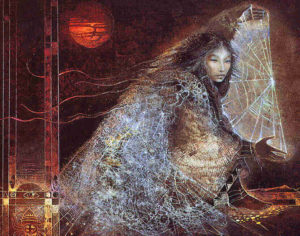Spider Grandmother (sometimes referred to as Spider Woman), is a female creation figure found in many mythologies of Native American tribes including Navajo, Keresan and Hopi, and though her role differs in each society she is generally seen as the source of human and animal life on earth. Folklore surrounding her envisions the universe as a great interconnected web, with the Grandmother seated at its centre controlling each strand as a spider does. Some folklore says that she created humans with a spider’s thread still attached to their head so they remain forever in her grasp, in another she is associated with the creation of the stars by spreading a web laced with dew over the night sky. Thus her ‘web’ comes to stand for many things; the interconnected energy of the universe, human life, and the matrix of our reality. She is considered to connect all nations, tribes and people within her web and thus is a figure also of unity. The fact that all life within the universe is held by her web means she is generally perceived as a figure of both creation and destruction as she holds the power of man’s fate, and her perceived power is such that many societies limit the telling of stories involving her to the winter months when it is safe to discuss certain dangerous spirits. However she is for some merely a figure of guidance and resourcefulness, and sometimes also symbolises the art of weaving. She is often linked to dreamcatchers due to their web-like pattern, and they are believed to help convey teachings of Spider Grandmother while people sleep, as well as affording her protection from bad dreams.
She may be seen as a precursor to The Great Goddess of Teotihuacan (or Teotihuacan Spider Woman) of the Aztec society from Teotihuacan (now Mexico), with artistic representations found in the Tepantitla and Tetitla murals. In these she is depicted surrounded by spiders and wearing an elaborate headdress with its most distinguishing feature probably being a nosepiece consisting of a bar with three circles from which four of five ‘fangs’ hang. However, the majority of other drawings or paintings of her simply show an old woman surrounded by a web.
Traditionally stories about Spider Grandmother were passed down orally through generations and in some of these tales she is also referred to as Earth Goddess. These oral accounts have been documented in books such as Spider Woman’s Web by Susan Hazen-Hammond, G.M. Mullett’s Spider Woman Stories and also inspired a seven act play by Murray Mednick called The Coyote Cycle.
-Scarlett Evans
Junior Girl
Girl Museum Inc.

